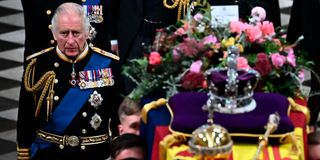Transition problems for King Charles include style as well as politics

Britain's King Charles III walks beside the coffin of Queen Elizabeth II as it leaves the Abbey at the State Funeral Service for Britain's Queen Elizabeth II, at Westminster Abbey in London on September 19, 2022.
What you need to know:
- The change of monarchs comes at a difficult time for the Commonwealth, with several members, such as Australia, facing internal pressures to remove the British monarch as their head of state.
- One area where the new king will need no lessons from his mother is that of religious belief.
- One aspect of the transition that has got many British people talking is whether King Charles’s personal style will differ from that of his mother.
So it is over… life in the UK returned to normal last week after 11 days of mourning the death at age 96 of Queen Elizabeth II, whose 70 years on the throne made her the longest reigning monarch in British history.
The statistics for the grieving period were breathtaking, including one that said an estimated four billion people, that is half of the population of planet earth, watched some part of the TV coverage of the Queen’s funeral on September 19.
That would make it the biggest live TV event in history.
That apart, more than a quarter of a million people filed past the Queen’s coffin in Westminster Hall over four days, having waited in queues of up to 20 miles for as long as 20 hours; the congregation for the funeral in Westminster Abbey totalled 2,000, of whom some 500 were visiting dignitaries, including foreign heads of state and government, such as US President Joe Biden.
That some of these latter, including Kenya’s President William Ruto, were asked to give up their cars and travel to the Abbey by bus raised the hackles of a number of African social media users, who saw hints of racism there.
However, commentators pointed out that the leaders of Canada, Australia and New Zealand, sometimes referred to as the “white Commonwealth”, also took the short bus ride to reduce excessive traffic flows.
New Zealand’s PM, Jacind Ardern, said she had no problem with the bus and wondered what the fuss was about, and Justin Trudeau, her opposite number in Canada, joked that “You can have interesting conversations on a bus”.
That said, such negative reactions are signals which King Charles and his advisers will need to take into account as he moves into his reign.
Kenya, for one, has strong economic and trade ties with the UK and is a Commonwealth member with the advantages this provides in terms of business and educational openings.
Historically, the country has one particular and unique link to the monarchy in that Princess Elizabeth was visiting Kenya when her father died and she became queen.
Mau Mau uprising
For some, however, a stronger memory would be of Britain’s role in pre-independent Kenya when its troops were deployed against the Mau Mau uprising of the 1950s.
Thousands of Kenyans were interned and subsequent reports claimed many were killed, tortured and otherwise maltreated.
King Charles, a septuagenarian with years of preparation behind him, will be well aware of these facts and is expected to press the benefits for both sides in maintaining the sort of good relations that have been upheld by the Presidents of independent Kenya down the years.
The change of monarchs comes at a difficult time for the Commonwealth, with several members, such as Australia, facing internal pressures to remove the British monarch as their head of state.
Other countries, predominantly Jamaica, are demanding that Britain pay reparations and issue an apology for its long-ago crimes of slavery.
One area where the new king will need no lessons from his mother is that of religious belief.
It was in 1994 that the then Prince Charles famously expressed the desire to be “Defender of Faith” rather than “Defender of the Faith”, one of the monarch’s traditional titles.
It took time, and change in the ethnic make-up of Britain, but the Queen eventually took on board such sentiments and began visiting mosques, temples, gurdwaras and synagogues.
In her traditional Christmas broadcast of 2000, she declared, “Christ’s example has taught me to respect and value all peoples of whatever faith or none.”
One aspect of the transition that has got many British people talking is whether King Charles’s personal style will differ from that of his mother.
The queen would accept bouquets of flowers from admirers and smile widely and often, but there was strictly no physical contact.
Posing for selfies
With King Charles, it is quite different. Already he has taken to shaking hands with members of the public behind crowd barriers, joking, laughing and posing for selfies.
This naturalness was evidenced in a rather different fashion during a visit to Hillsborough Castle in Northern Ireland.
The king was in the process of signing the visitors’ book when the pen he had been given began leaking ink all over the royal fingers. Charles stood up and protested furiously, “Oh, God, I hate this stinking thing.”]
Taking a handkerchief from his pocket, he grumbled testily, “I can’t bear this bloody thing, it happens all the time.”
A similar mishap had occurred a few days earlier, but somehow you could not see the Queen reacting in quite that fashion.
On the other hand, could you really blame someone who had just been given a vast new job at the age of 73 for showing that a human person lies behind the royal façade?





